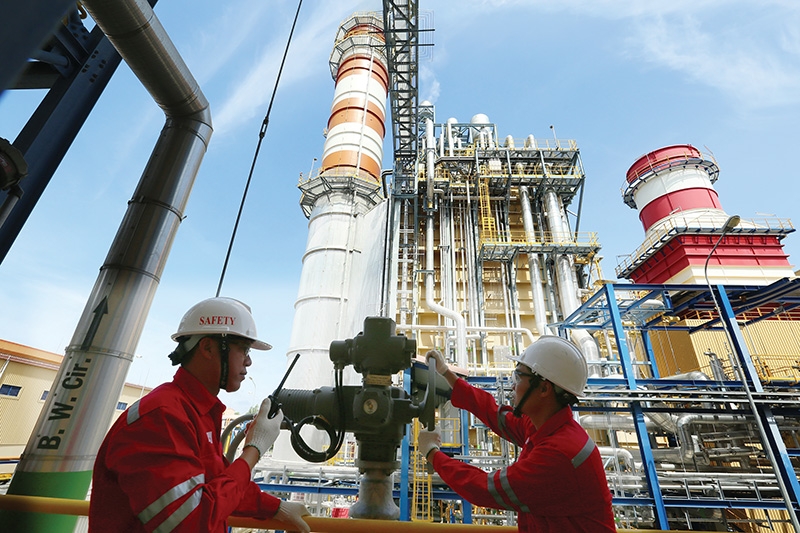Going on the attack for a self-reliant economy
 |
| Recovery across industries and services have all been affected by this year’s woes. Photo: Le Toan |
The Asian Development Bank (ADB) last week lowered Vietnam’s 2021 growth forecast to 5.8 from 6.7 per cent previously. According to the ADB, the relatively slow implementation of vaccinations and the application of prolonged physical distancing measures in the country’s largest growth regions have had a major impact on trade flows and constrained economic activities.
Vietnam’s economy in the first six months of 2021 was not much stronger than in 2020. General Statistics Office data showed that GDP growth in the first six months of 2021 slowed down, reaching 5.64 per cent, albeit still higher than the 1.81-per-cent growth rate of the first six months of 2020, but lower than in 2018 and 2019.
Thus, GDP growth did not meet the government’s target. Furthermore, the potential GDP growth rate declined for the 14th consecutive quarter and was significantly lower than the actual growth rate, indicating efforts to address the structural problems of the economy. However, the economy has only slowly improved since 2014.
Dr. Le Duy Binh, director of Economica Vietnam, said that this outbreak has directly affected Vietnam’s production capacity in several major industrial zones and economic hubs. “The speed of private enterprises’ implementation of business initiatives, foreign-invested projects, the disbursement of public investment capital, and the recovery of the industries and services in the country service all have been negatively affected,” Binh said.
Meanwhile, the government’s policies to support businesses show only short-term effects, according to Binh. “Household businesses and the informal economy, which account for more than 30 per cent of Vietnam’s GDP, have been greatly affected by the outbreak due to temporary suspensions or inactivity.”
The Central Institute for Economic Management (CIEM) two weeks ago announced two scenarios for GDP growth in 2021. The first scenario makes the assumption that the pandemic is under control in October, with growth increasing shortly thereafter, reaching 5.9 per cent. The second scenario would presume that the pandemic is controlled in August, with Vietnam’s GDP growth reaching 6.2 per cent.
Several analysts believed that economic growth will recover in the last months of the year. Backed by the global recovery boosting exports, Vietnam’s GDP grew by 5.64 per cent in the first half of this year, compared to just 1.81 per cent in the same period of 2020. With this figure, Vietnam’s rate was just behind China (18.3 per cent) and Singapore (14.3 per cent).
“The full-year growth outlook can be maintained thanks to positive changes in monitoring,” commented Nguyen Anh Duong, head of the CIEM’s General Research Department.
“The government’s approach and management during the current wave were flexible compared to the previous infection waves as it is focusing on both, preventing the pandemic and creating conditions to promote production,” Duong said.
The recovery momentum exists, but “realising the GDP growth target for the year at 6.5 per cent remains a huge challenge,” Duong added.
The industrial production index recovered, increasing sharply to 13.01 per cent in the second quarter, but mainly concentrated in low-tech industries, such as processing and assembly, with low added value. The activity of the service sector recovered at a low level, with tourism and transport still facing many difficulties.
Duong also called for a change in thinking. “It is necessary to avoid defensive thinking so that the economy can be independent and self-reliant, and that we can work in the direction to proactively withstand the pandemic as well as external shocks,” Dung said.
Vietnam’s growth may be slower than that of other countries in the region if it fails to seize the opportunities from the rapid recoveries of its major partners, Vo Tri Thanh, former deputy director of the CIEM, pointed out, adding that “Vietnam should not only overcome the pandemic but also keep pace with the recovery momentum of the world.”
Economic growth in the last months of the year is closely associated with three common difficulties in the global economy, according to experts. Firstly, the supply scarcity continues to increase, and competition is still strong, pushing commodity prices. Next, some countries halted monetary easing in the context of a rising inflation rising. Lastly, logistics capacity is no longer as guaranteed as before the pandemic, with the cost of renting empty containers increasing dramatically.
Currently, growth between regional countries remains uneven. While some of Vietnam’s major partners, such as the United States or Europe, are seeing positive growth prospects, a number of major financial institutions have lowered their growth forecasts for some ASEAN countries due to developments in the region. Even China, the region’s strongest economic recovery in the first half of 2021, is showing signs of slowing down.
Thanh’s analysis goes hand-in-hand with the assessment of international organisations. The ADB lowered its growth forecast for developing Asia this year from 7.3 to 7.2 per cent.
Successful implementation of Vietnam’s goals of pandemic fighting and economic development faces many difficulties, while production can only be stabilised when there are enough vaccines – but the numbers remains low.
ADB chief economist Yasuyuki Sawada said that, in addition to containment and vaccination measures, the recovery of economic activities will be key to ensuring a green, inclusive, and sustainable recovery.
| Nguyen Thi Huong - General director, General Statistics Office
GDP growth in the first six months of 2021 was quite good at 5.64 per cent, especially amid the pandemic, which had a significant impact on the economy, leading to some doubts about the data. Currently, the General Statistics Office is compiling and publishing its analysis of GDP according to various methods. GDP under the income method is calculated and published every five years when there are sufficient information sources from the census and the intersectoral balance sheet survey. Quarterly and full-year GDP figures are compiled simultaneously by applying the production and usage methods. In which, the production method is the main one because the information collected from this source is often more accurate and complete than others. By calculating the GDP through both these methods and from different sources of information – that is, from the producer and from the consumer side – the results will not completely coincide. The GDP results from the using method may be higher or lower than the results compiled by the production method, and this difference is within the error range of ±5 per cent. Assoc. Prof. Dr. Pham The Anh - Chief economist, Institute for Economic and Policy Research
The economic outlook in the last months of the year depends heavily on the speed and scale of vaccinations, the vaccines’ effectiveness and side effects, disease prevention measures, and packages to support and promote growth in the country. Our institute gives three recommendations related to economic recovery. Firstly, Vietnam needs an overall and consistent strategy to deal with the pandemic; inadequacies related to cross-contamination in isolation areas, medical declarations, and disruptions in goods circulation due to extreme measures; and the lack of medical equipment. Secondly, the government and ministries should urgently deploy and disburse support packages for unemployed workers, especially those in the informal sector. Thirdly, fiscal policy should focus on promoting disbursement of large infrastructure projects at the national level, laying the foundation for post-pandemic recovery. Along with that, accommodative monetary policy should be implemented with financial supply growth under control at an appropriate level and risk control measures at a moderate level. Assoc. Prof. Dr. Dinh Trong Thinh - Academy of Finance
It is forecast that in the last six months of 2021, if the pandemic remains complicated, Vietnam’s economy may grow 6.8-7 in this period, with possible inflation for the whole year ranging between 3.3 and 3.5 per cent. Core inflation in June and the first six months of 2021 are both the lowest in the past five years. The main reason for the increase in the consumer price index (CPI) in May and June is the increase in prices of many input materials for production, following global world prices, as well as prices for electricity and water. In 2021, Vietnam’s economy is forecast to recover and develop strongly, which will put great pressure on prices, interest rates, exchange rates, and inflation. As a deeply open economy, the price of raw materials and imported materials will push up the inflation rate. In order to keep the CPI growth rate below 4 per cent in 2021, a number of measures need to be well implemented, and it is necessary to continue to maintain macroeconomic stability. Economic growth will be an effective support factor for stabilising the economy, helping to avoid skepticism of businesses and the population, and avoiding “psychological inflation”. |
What the stars mean:
★ Poor ★ ★ Promising ★★★ Good ★★★★ Very good ★★★★★ Exceptional
Related Contents
Latest News
More News
- Businesses ramp up production as year-end orders surge (December 30, 2025 | 10:05)
- Vietjet chairwoman awarded Labour Hero title (December 29, 2025 | 13:06)
- How to unlock ESG value through green innovation (December 29, 2025 | 10:03)
- AI reshapes media and advertising industry (December 29, 2025 | 08:33)
- FPT and GELEX sign deal to develop blockchain tech for global markets (December 29, 2025 | 08:29)
- Vietnam’s GDP forecast to grow by 9 per cent in 2026 (December 29, 2025 | 08:29)
- Women entrepreneurs are key to Vietnam’s economic growth (December 29, 2025 | 08:00)
- Vietnam's top 500 value-creating enterprises announced (December 27, 2025 | 08:00)
- The PAN Group shaping a better future with ESG strategy (December 26, 2025 | 09:00)
- Masan Consumer officially lists on HSX, marking the next phase of value creation (December 25, 2025 | 13:20)




 Tag:
Tag:




















 Mobile Version
Mobile Version